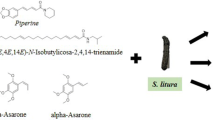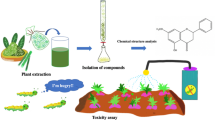Abstract
Biological activities of the salannin type of limonoids isolated fromAzadirachta indica A. Juss were assessed using the gram pod borerHelicoverpa armigera (Hubner) and the tobacco armywormSpodoptera litura (Fabricius) (Lepidoptera: Noctuidae). Inhibition of larval growth was concomitant with reduced feeding by neonate and third instar larvae. All three compounds exhibited strong antifeedant activity in a choice leaf disc bioassay with 2.0, 2.3 and 2.8 (μ/cm2 of 3-O-acetyl salannol, salannol and salannin, respectively deterring feeding by 50% inS. litura larvae. In nutritional assays, all three comounds reduced growth and consumption when fed to larvae without any effect on efficiency of conversion of ingested food (ECI), suggesting antifeedant activity alone. No toxicity was observed nor was there any significant affect on nutritional indices following topical application, further suggesting specific action as feeding deterrents. When relative growth rates were plotted against relative consumption rates, growth efficiency of theH. armigera fed diet containing 3-O-acetyl salannol, salannol or salannin did not differ from that of starved control larvae (used as calibration curve), further confirming the specific antifeedant action of salannin type of limonoids. Where the three compounds were co-administered, no enhancement in activity was observed. Non-azadirachtin limonoids having structural similarities and explicitly similar modes of action, like feeding deterrence in the present case, have no potentiating effect in any combination.
Similar content being viewed by others
References
Blaney W M, Simmonds M S J, Ley S V, Anderson J C and Too-good P L 1990 Antifeedant effects of azadirachtin and structurally related compounds on lepidopterous larvae;Entomol. Exp.Appl. 55 149–160
Champagne D E, Koul O, Isman M B, Scudder G G E and Towers G H N 1992 Biological activity of limonoids from the Rutales;Phytochemistry 31 377–394
Chen W, Isman M B and Chiu S -F 1995 Antifeedant and growth inhibitory effects of the limonoid toosendanin andMelia toosendan extracts on the variegated cutworm,Peridroma saucia;J. Appl. Entomol. 119 367–370
Govindachari T R, Narasimhan N S, Suresh G, Partho P D and Gopalakrishnan G 1996 Insect antifeedant and growth-regulating activities of salannin and other C-seco limonoids from neem oil in relation to azadirachtin;J. Chem. Ecol. 22 1453–1461
Ishida M, Serit M, Nakata K, Juneja L R, Kim M and Takahashi S 1992 Several antifeedants from neem oil,Azadirachta indica A. Juss., againstReticulitermes speratus Kolbe (Isoptera: Rhinotermitidae);Biosci. Biotech. Biochem. 56 1835–1838
Isman M B, Koul O, Luczynski A and Kaminski J 1990 Insecticidal and antifeedant bioactivities of neem oils and relationship to azadirachtin content;J. Agric. Food Chem. 38 1406–1411
Koul O 1992 Neem allelochemicals and insect control; inAllelopathy: Basic and applied aspects (eds) S J H Rizvi and V Rizvi (London: Chapman and Hall) pp 389–412
Koul O and Isman M B 1991 Effects of azadirachtin on the dietary utilization and development of the variegated cutworm,Peridroma saucia;J. Insect Physiol. 37 591–598
Koul O, Smirle M J and Isman M B 1990 Asarones fromAcorus calamus L. oil: Their effect on feeding behaviour and dietary utilization inPeridroma saucia;J. Chem. Ecol. 16 1911–1920
Koul O, Shankar J S and Kapil R S 1996 The effect of neem allelochemicals on nutritional physiology of larvalSpodoptera litura;Entomol. Exp. Appl. 79 43–50
Koul O, Multani J S, Singh G and Wahab S 2002 Bioefficacy of toosendanin fromMelia dubia (syn.M. azedarach) against gram pod-borer,Helicoverpa armigera (Hubner);Curr. Sci. 83 1387–1391
Koul O, Multani J S, Singh G, Daniewski W M and Berlozecki S 2003 6β-Hydroxygedunin fromAzadirachta indica, its potentiation effects with some non-azadirachtin limonoids in neem against lepidopteran larvae;J. Agric. Food Chem. 51 2937–2942
Koul O, Multani J S, Goomber S, Daniewski W M and Berlozecki M 2004 Activity of some non-azadirachtin limonoids fromAzadirachta indica against lepidopteran larvae;Aust. J. Entomol. 43 189–195
Koul O, Shankar J S, Mehta N, Taneja S C, Tripathi A K and Dhar K L 1997 Bioefficacy of crude extracts ofAglaia species (Meliaceae) and some active fractions against lepidopteran larvae;J. Appl. Entomol. 121 245–248
Kraus W 1984 Biologically active compounds from Meliaceae;Stud. Org. Chem. 17 331–345
Kraus W 2002 Biologically active ingredients; inThe neem tree, Second Edition (ed.) H Schumutterer (Mumbai: Neem Foundation) pp 39–111
Kraus W and Cramer R 1981 Neue tetranortriterpenoide mit insektenfraβhemmender wirkung aus neem-Öl;Liebigs Ann. Chem. 181–189
Kraus W, Klenk A, Bokel M and Vogler B 1987 Tetanorterpenoid — lactame mit insektenfraβhemmender wirkung ausAzadirachta indica A. Juss (Meliaceae);Leibigs Ann. Chim. 337–340
Kraus W, Bokel M, Schwinger M, Vogler B, Soellner R, Wendisch D, Steffens R and Wachendorff U 1993 The chemistry of azadirachtin and other insecticidal constituents of Meliaceae; inPhytochemistry and agriculture (eds) T Van Beek and H Breteler (Oxford: University Press) pp 18–39
Kubo I, Matsumoto A, Matsumoto T and Klocke J A 1986 New insect ecdysis inhibitory limonoid deacetylazadirachtinol isolated fromAzadirachta indica (Meliaceae) oil;Tetrahedron 42 489–496
Liu Y -B, Alford A R, Rajab M S and Bentley M D 1990 Effects and mode of action of citrus limonoids againstLeptinotarsa decemlineata;Physiol. Entomol. 15 37–45
Mendel M J, Alford A R and Bentley M D 1991 A comparison of the effects of limonin on Colorado potato beetle,Leptinotarsa decemlineata and fall armyworm,Spodoptera frugiperda, larval feeding;Entomol. Exp. Appl. 58 191–194
Mendel M J, Alford A R, Rajab M S and Bentley M D 1993 Relationship of citrus limonoid structure to feeding deterrence against fall armyworm (Lepidoptera: Noctuidae) larvae;Environ. Entomol. 22 167–173
Mordue A J and Blackwell A 1993 Azadirachtin: An update;J. Insect Physiol. 39 903–924
Rajab M S and Bentley M D 1992 Further, minor tetranortriterpenoids fromMelia volkensii;Bull. Chem. Soc. Ethiop. 6 97–103
Rajab M S, Bentley M D, Alford A R and Mendel M L 1988 A new limonoid insect antifeedant from the fruit ofMelia volkensii;J. Nat. Prod. 51 168–171
Rojatkar S R, Bhat V S, Kulkarni M M, Joshi V S and Nagasampagi B A 1989 Tetranortriterpenoids fromAzadirachta indica;Phytochemistry 28 203–205
Simmonds M S J, Blaney W M, Ley S V Anderson J C and Toogood P L 1990 Azadirachtin: structural requirements for reducing growth and increasing mortality in lepidopterous larvae;Entomol. Exp. Appl. 55 169–181
Wheeler D A and Isman M B 2001 Antifeedant and toxic activity ofTrichilia americana extract against the larvae ofSpodoptera litura;Entomol. Exp. Appl. 98 9–16
Yamasaki R B and Klocke J A 1989 Structure-bioactivity relationships of salannin as an antifeedant against the Colorado potato beetle (Leptinotarsa decemlineata);J. Agric. Food Chem. 37 1118–1124
Yamasaki R B, Ritland T G, Barnby M A and Klocke J A 1988 Isolation and purification of salannin from neem seeds and its quantification in neem and chinaberry seeds and leaves;J. Chromatogr. 477 277–283
Author information
Authors and Affiliations
Corresponding author
Rights and permissions
About this article
Cite this article
Koul, O., Singh, G., Singh, R. et al. Bioefficacy and mode-of-action of some limonoids of salannin group fromAzadirachta indica A. Juss and their role in a multicomponent system against lepidopteran larvae. J. Biosci. 29, 409–416 (2004). https://doi.org/10.1007/BF02712112
Received:
Revised:
Published:
Issue Date:
DOI: https://doi.org/10.1007/BF02712112




